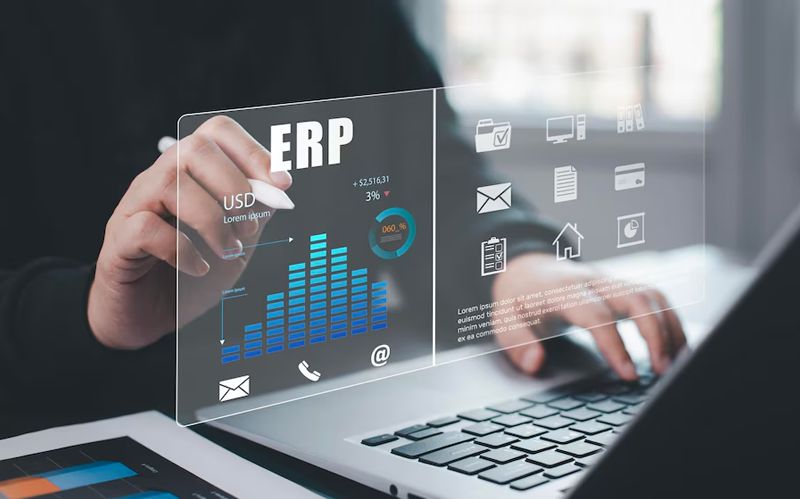
11 Nov Unleashing the Power of ERP for Seamless Business Operations
In today’s fast-paced business world, managing multiple aspects of an organization—finance, supply chain, human resources, and customer relations—can be overwhelming. This is where Enterprise Resource Planning (ERP) systems come into play. An ERP is designed to integrate and streamline key business processes, offering organizations a unified system to improve efficiency, decision-making, and overall performance.
However, beyond the traditional uses of ERP, there are unique and creative ways this powerful tool can revolutionize the way businesses operate. Let’s explore some of the more unconventional yet impactful applications of ERP systems.
1. ERP for Data-Driven Customer Personalization
Traditionally, ERP systems focus on streamlining internal processes. But what if ERP could help businesses develop deeper relationships with their customers? By integrating customer data from various sources—sales, support, social media, and website activity—into a centralized ERP system, businesses can gain comprehensive insights into their customers’ behavior and preferences.
These insights can then be used to personalize marketing campaigns, improve product recommendations, and even tailor customer service. Imagine a system where your ERP can automatically trigger special offers or discounts for loyal customers based on their purchasing history or browsing behavior. This level of personalization, powered by ERP, can significantly boost customer satisfaction and loyalty.
2. ERP for Predictive Maintenance and IoT Integration
Gone are the days when companies had to rely on reactive maintenance strategies, fixing equipment only after it breaks. With the rise of the Internet of Things (IoT), ERP systems have evolved to integrate with IoT devices, creating an intelligent network of connected systems that help businesses predict maintenance needs before they become a problem.
Using real-time data from machinery, sensors, and other IoT devices, ERP systems can monitor the health of assets and predict potential failures. This enables businesses to schedule proactive maintenance, reduce downtime, and extend the lifespan of equipment. By embracing predictive maintenance, companies can save on repair costs, optimize production schedules, and reduce unplanned disruptions in operations.
3. ERP for Advanced Supply Chain Visibility and Blockchain Integration
Supply chain management is often one of the most complex and error-prone aspects of business operations. However, by integrating blockchain technology with ERP systems, businesses can gain unprecedented transparency and traceability throughout their supply chain.
Blockchain can provide an immutable, transparent record of every transaction, ensuring that all parties involved—suppliers, distributors, and customers—can access real-time, verifiable information about the product journey. This level of transparency reduces fraud, enhances accountability, and ensures that products meet quality standards before reaching the market.
When combined with ERP, businesses can automate order tracking, inventory updates, and payment processes, leading to a more efficient, transparent, and secure supply chain that minimizes risk and maximizes profitability.
4. ERP for Agile Decision-Making in a Dynamic Market
In today’s volatile business environment, companies must be able to adapt quickly to changing market conditions. Traditional ERP systems might provide periodic reports and insights, but real-time data access is the true game-changer.
Modern ERPs offer advanced analytics and dashboards that provide up-to-the-minute information about your business. This allows managers to make decisions quickly and confidently, without having to wait for weekly or monthly reports. By embedding AI and machine learning algorithms into the ERP system, businesses can also receive predictive analytics that anticipate changes in market trends, customer preferences, or operational bottlenecks.
For example, if the system detects a drop in inventory levels that could disrupt production, it can automatically alert purchasing managers and suggest reordering strategies. This level of agility helps businesses stay ahead of competitors and respond proactively to challenges and opportunities in the market.
5. ERP for Human-Centered Workforce Management
Most ERP systems streamline operations related to supply chain and finance, but what about the most valuable asset of any organization—its people? Human resource management has often been a separate function, but integrating it with the ERP system can create a holistic view of the workforce, enabling better talent management, retention, and employee engagement.
ERP systems can track employees’ performance, skills, and career development, while also helping with scheduling, time tracking, and benefits management. Additionally, they can integrate with employee wellness platforms to monitor and improve workplace health, satisfaction, and overall performance. By building a workforce-centered ERP system, organizations can improve employee productivity, reduce turnover, and foster a culture of growth.
6. ERP for Environmental Sustainability and Resource Management
As businesses become more conscious of their environmental impact, integrating sustainability into operations has never been more important. Modern ERP systems offer tools that help track and manage energy consumption, waste reduction, and compliance with environmental regulations.
For example, an ERP can monitor carbon footprints, track resource usage (such as water and energy), and identify opportunities to reduce waste or optimize energy consumption. With sustainability analytics, businesses can set and measure goals for reducing environmental impact, improve their corporate social responsibility (CSR) performance, and even gain a competitive edge by promoting their green practices to consumer.
Conclusion: Reimagining ERP for the Future
As businesses continue to evolve, so must their tools. The traditional role of ERP systems as operational back-office solutions is expanding. By integrating innovative technologies like IoT, blockchain, AI, and real-time analytics, ERP systems are becoming powerful platforms that drive growth, improve customer experiences, and enable businesses to stay competitive in an increasingly complex world.
At PT KDN, we help businesses leverage the full potential of ERP systems by crafting custom solutions tailored to their unique challenges and opportunities. Whether it’s improving supply chain transparency, driving predictive maintenance, or enhancing workforce management, ERP is a dynamic tool that can transform the way your business operates—creating a smarter, more sustainable future.


Sorry, the comment form is closed at this time.